Bugatti
1909: After working for others, Ettore Bugatti (1881-1947) built his first car, the type 13, at Molsheim, Alsace.
1910: "Work began on the type 13 in 1910." — Bugatti
The 1913 4-cylinder 5-litre Bugatti type-18 sports 2-seater, ‘Black Bess’ (chassis #474), sold for €2,427,500 at Bonhams Automobiles d'Exception a Retromobile auction in Paris, 7 February 2009.
1921: A development of the type 13, the type 13 'Brescia', 1,453cc, 4-cyl., 4 valves/cyl., 490kg, known after the Grand Prix for Voiturettes in Brescia in September 1921 where type 13s finished 1st, 2nd, 3rd and 4th. — Bugatti
1922: The type 30, 8-cyl., 2-litres, ohc, 3-valves/cyl. — Bugatti
- 1924-1931, the racing/road type 35, one of the best looking Bugattis, straight-8, 2-litres. And later 2.3-litre supercharged T35B.
- On 13 May 2022 a 1927 Bugatti T35B, chassis #4888, engine #127 TC sold for €2,000,000 at Bonhams Monaco auction.
- 1925-1930, type 37, 4-cylinder 1.5-litre, and supercharged T37A.
- A 1929 Bugatti type 37 Grand Prix two-seater, chassis #37383, engine #286, sold for €1,150,000 at Bonhams Zoute auction 8 October 2023.
1926-1933 the luxurious type 41 Royale, straight-8, sohc, 12.7-litre was the wrong car for the times and only six were built.
- 1926-1932 type 50, sports car in various body styles, dohc.
- On 25 May 2019, a 1931 type 50 roadster sold for €1,411,250 at RM Sotheby's Villa Erba auction.
- 1931-1934 type 51, straight-8, 2.3-litre supercharged.
- In August 2016, a type 51 sold for us$4,000,000 at Bonhams 'Quail' auction.
1932: Two (3?) type 53, straight-8, 4.9-litre, supercharged, hill climb / racing cars were built with four wheel drive.
1932-1934, type 54, straight-8, 5-litre supercharged.
A 1932 Bugatti type 55 two-seat Super Sport, coachwork (1933) by Carrosserie Figoni, chassis #55221, engine #26 (ex 55223), sold for €4,600,000 at Bonhams 'Les Grandes Marques' auction, Paris, 6 Feb. 2020. Chassis #55220, engine #21, a 1932 Super Sports Roadster, coachwork by Jean Bugatti Design, sold for us$7,100,000 at Bonhams 'Amelia Island' auction 5 March 2020.
- 1934-1939: Type 57 3.3-litre straight-8 unsupercharged, also
1935-1939 57C supercharged,
1936-1938 57S unsupercharged and
1936-1938 57SC supercharged.
The 57S and 57SC were lowered and had a shorter wheelbase
[Geo00].
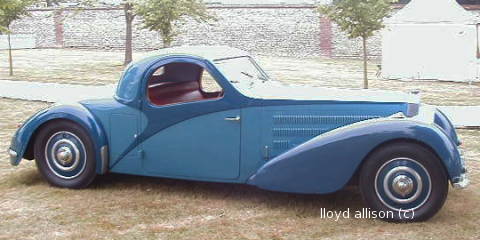
a 1937 type 57- Racing versions won the Le Mans 24-hour race in 1937 and 1939.
- A 1937 Bugatti type 57S sold for €3,417,500 (au$6.7million) at Bonhams Automobiles d'Exception a Retromobile auction in Paris, 7 February 2009. A 1938 type 57C Aravis Special Cabriolet, chassis #57768, engine #75C, sold for us$6,000,000 at Goodings Mullin Collection Auction, California, 26 April 2024.
- And, "Bugatti sold only three of the hand-crafted type 57 Atlantic cars [coupes] to customers ..."
- "British banker Victor Rothschild, originally without a supercharger,
in grey-blue. This vehicle, with chassis number 57 374,
is now known as the 'Rothschild Atlantic'.
- "The 'Holzschuh Atlantic', the third car built, with chassis number 57 473, was delivered to Jacques Holzschuh of France in October 1936. The second owner of the car, a collector, died in an accident on a level crossing. The Bugatti was completely destroyed. Decades afterwards, it was the subject of a complex restoration, although the engine could not be saved.
- "Fashion designer Ralph Lauren is the owner of the last Atlantic produced, with chassis number 57 591, the 'Pope Atlantic' was completed in May 1938 – its first owner was the Briton R.B. Pope." — B (2019).
- "Jean Bugatti had the second Atlantic [57 453] made for himself." — B (2019). This car has been lost.
- "The 'Holzschuh Atlantic', the third car built, with chassis number 57 473, was delivered to Jacques Holzschuh of France in October 1936. The second owner of the car, a collector, died in an accident on a level crossing. The Bugatti was completely destroyed. Decades afterwards, it was the subject of a complex restoration, although the engine could not be saved.
- And, "Just 17 Type 57S chassis were originally supplied with Atalante coachwork — Goodings '22.
- A 1937 57SC Atalante sold for us$7,920,000 at the 2008 Pebble Beach auction. A 1936 Bugatti Type 57SC Atlantic, chassis #57374, sold reputedly for over us$30 million, 5 May 2010. A 1937 Bugatti 57S Atalante chassis #57523, engine #23S, sold for us$10,345,000 at Gooding's Pebble Beach auction, 19-20 August 2022.
1947: Ettore Bugatti died.
1963: Bugatti was bought by Hispano-Suiza (no longer making cars) which was later acquired by SNECMA [Geo00].
- 1991-1995: The last "proper" Bugattis were built in the 1950s,
but the name was revived in the 1990s with
the 3.5-litre V12, quad turbo., mid-engined EB110
(Ettore Bugatti 110th anniversary), us$456K.
The car had a 6-speed gearbox and four wheel drive and
was said to be capable of 210+mph.
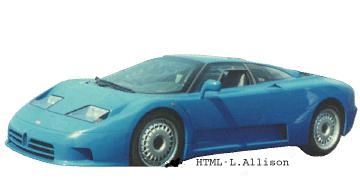
EB110 - A 1995 Bugatti EB110 SS 'Sport Competizione - Le Mans' sold for €941,700, us$1,050,890, at the Retromobile Salon auction, Paris, 6 February 2016. A 1994 EB110 Super Sport, chassis #ZA9BB02E0RCD39012, engine #086 sold €2,030,000 for at RM Sothebys Retromobile auction 6 February 2019. A 1994 EB110 Super Sport, chassis #ZA9BB02E0RCD39011, sold for €2,242,500 at Bonhams Zoute auction 10 October 2021. A 1994 ED110 GT, chassis #ZA9AB01SORCD39071, engine #094 sold for €1,150,000 at Bonhams Zoute auction 8 October 2023.
1998: Volkswagen acquired the Bugatti name and showed a front-engined W18 Bugatti concept car (the 18 meaning 18 cylinders!) at the 1998 Paris Motor show. The W format of cylinder banks, was a development of VW's narrow angle 5- and 6-cylinder V engines, but this flight of fantasy had 6.3 litres, 72-valves and direct (petrol) injection to achieve 410kW power and 650Nm torque. It raised the stakes on even VW's own W12 super sports car concept, perhaps trying to emulate the historic Bugatti Royale. The EB118 Bugatti had an aluminium chassis (shades of Audi) and used four wheel drive to get the power to the road.
- 1999: VW showed the Bugatti Chiron
mid-engined concept car at the Frankfurt Motor Show.
The Chiron was 4.2m long and 1.5m high.
Powered by a W18, 6.3 litre engine with 72-valves (=4x18), and
producing 408kW of power and 650Nm of torque, the Chiron could
only be described as extravagant.
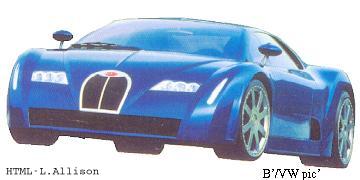
1999
- 2003:
VW-owned Bugatti continued with plans to
release the rear-engined, W16 (1999 show car was W18), 4×turbo-charged,
all wheel drive Veyron supercar
– 736kW, 1250Nm, 1600kg – in 2004.
It's a bit silly really.
(Pierre Veyron won the 1939 Le Mans race for Bugatti.)
- 2007: Bugatti allowed Top Gear's James May to verify the 250mph top speed (253 in fact) of the Veyron on VW's test track, although they would not allow the "Stig" to take it around the popular TV show's own test track.
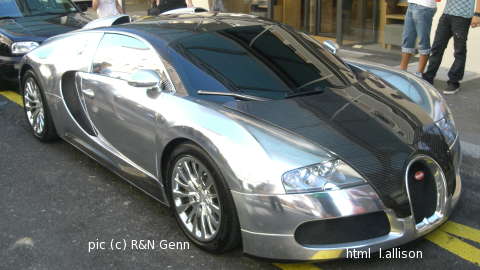
2008
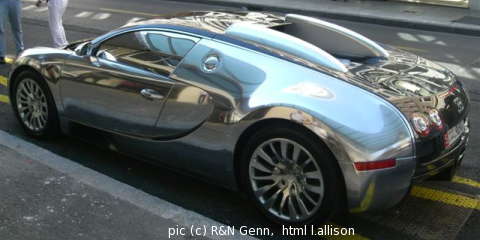
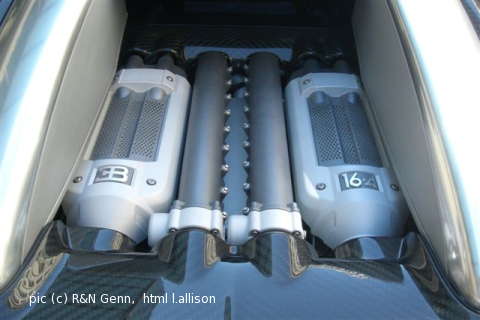
- 2007: Bugatti allowed Top Gear's James May to verify the 250mph top speed (253 in fact) of the Veyron on VW's test track, although they would not allow the "Stig" to take it around the popular TV show's own test track.
- A 2010 Veyron 16.4 Grand Sport 'Sang Bleu', chassis #ZFFGJ34B000084116, sold for us$3,085,000 at RM Sothebys Miama auction, 1-2 March 2024.
2009 September: Bugatti revealed the front-engined 16 C Galibier 4-door prototype fitted with a version of the 8-litre W16 engine with "two stage supercharging" and capable of running on ethanol. The car had ceramic brakes and four wheel drive.
2010, July 4: A Bugatti Veyron 16.4 Super Sport raised the speed record for a “production” car to 431.07km/h (267.9mph).
2011, June 24: "The final Bugatti Veyron has now been ordered ..." — B.
2012:
The 4-door Bugatti Galibier due to go on sale
(also see 2009).
The project was cancelled ~2013.
- 2016, March, Geneva: Bugatti revealed a pre-production Chiron, looking very much a Veyron+, 8-litre, W16, 4-turbo, 1,103kW, 1600Nm, 400+km/h (a distant resemblance to the 1999 'Chiron' concept car). Deliveries to customers began in March 2017. In December, Bugatti announced that it had delivered its target of 70 Chirons for 2017.
- In 2024 a 2017 Bugatti Chiron 'La Mer Argentee', chassis #VF9SP3V30HM795026, sold for €2,950,000 at RM Sotheby's Paris auction (31 Jan.) and a 2022 Bugatti Chiron Super Sport 300+ Coupe, vin #VF9SW3V32NM795009, sold for us$5,175,000 at Bonhams Scottsdale auction (25 Jan.).
2019, September 2: "A pre-production vehicle of a Bugatti Chiron derivative [was] the first hyper sports car to break the magic 300-mile-per-hour barrier (482.80 km/h). [And] Bugatti has set a new TUV-certified speed record with 304.773mph (490.484 km/h). ..." — Bugatti. (One way, on a test track.)
2021 November 2: "Rimac Automobili and Bugatti Begin Operating Under New Company: Bugatti Rimac ..." — Rimac Automobili.
2022 August 20: The limited (99) edition Bugatti 'Mistral' roadster (open) was shown at Monterey, said to be Bugatti's last W16-engined car. Should an electric or hybrid be expected next? (See below.)
2024 June 20: Bugatti revealed the Tourbillon, a hybrid (800hp) with a 8.3-litre "naturally aspirated" V16 (not W16) ICE (1000hp), total 1800hp, resembles the Chiron with hints of the type 57SC Atlantic (see 1930s), "customer deliveries in 2026 ... from €3.8m" — B. (Deliveries 2026?)